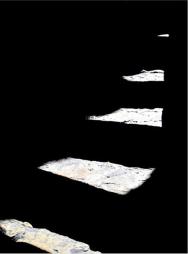You are currently browsing the category archive for the ‘contemplation’ category.
About a month ago I made a mistake. It happened sometime between my early morning preparation for waiting worship and the rise of Meeting.
The concept of the transpersonal is one which I have thought I understood intellectually for decades, going back to my naïve fascination with mystical paths in the 1970s, and maturing through years of contemplation and study.
That First Day, though, the concept became viscerally alive as I read a selection in The Essential Ken Wilber: An Introductory Reader (9-11). Wilber quotes Emerson’s assertion, “The soul knows no persons,” and explains that transpersonal means “personal plus,” a transcending of the personal which enfolds it into a larger whole.
Then Wilber asks:
But what could an actual “transpersonal” experience really mean? It’s not nearly as mysterious as it sounds…. You yourself can, right now, be aware of your objective self, you can observe your individual ego or person, you are aware of yourself generally.
But who, then, is doing the observing?
Here is a reply from Emerson:
The soul in man is not an organ,…not a function,…not a faculty, but a light; is not the intellect or the will, but the master of the intellect and the will…. From within or from behind, a light shines through us upon things and makes us aware that we are nothing, but the light is all.
Something about this flipping of the familiar Quaker metaphor gave me an opening. Conventionally, we modern Quakers say that individuals have a “light within.” Emerson says, instead, that the light is the reality, and that we individuals are simply something through which it shines upon the world.
An opening is an experience of suddenly recognizing what one already knew but had not seen so clearly before. That was what happened for me before waiting worship on that First Day. I therefore went to Meeting eager to sit in this new awareness with my fellow Friends.
Mistake.
Granted, I centered down sooner and deeper than is usual for me, and the whole of the hour was profound. No sense of needing to speak, just an expectation that the others were sharing what I “knew.” Until rise of Meeting…when I realized that the room was full of visitors whom I had never met before, and that I didn’t know if any of the others around me “knew” what I “knew.”
I haven’t felt so profoundly alienated from those around me in a long time. It took me several days to recognize that it was expectation which summoned up that feeling. Nothing about the other people in Meeting that First Day brought it forth. Just expectation.
So….
A month later, sitting in waiting worship yesterday. With my eyes literally open, so that I could recognize and greet each person who joined the circle.
Then the hour of deep silence, eyes now closed, sending my attention person by person around the circle, noticing however much or little I knew of each individual—without analysis or judgment. Nurturing a deep sense of no expectation.
At the rise of Meeting, for whatever reason, Friends immediately began exchanging their theories and anxieties about gluten and sugar and diet and genetically altered crops and the pervasiveness of processed foods and the impacts on physical and mental health…and…and….
I often feel distressed if worship, for me a deeply contemplative experience, leaps right into mundane, socio-economic discussion. My usual disappointment with such follow-ups to worship is that I long for something more “spiritual” in the way of public sharing.
Yet something different happened yesterday. I just listened. I did not feel that false need. I just listened.

And then, almost by surprise, the conversation shifted from anxious “me too” focus on material concerns. One Friend began to tell of her work in India, helping women and children whose men have met agricultural and financial failure to find new, simple economic grounding in the world.
The Meeting’s attention centered down. All that preliminary voicing of intellectual and emotional concerns dissolved into a sort of harmony of appreciation that our Friend and her colleagues were doing something real, with real people, in the real world.
The light, which often gets shrouded by our abstract concerns, shone through us onto people we don’t even know in a place most of us have never been.
For a while we were more than individuals. We were in unity.
A light shines through us upon things and makes us aware that we are nothing, but the light is all.
And so it is,
Blessèd be.
Michael
On the floating dock below Bartram Campus of Bolles School, before Friends Meeting a few weekends ago, I looked north into the shadows and saw the scene I have called Glyphs of wood and water. The water so still, the curves of wood almost speaking aloud.
I turned to the south then, where the mid-morning sun reached the creek from above the trees.
Blessèd Be,
Michael
Friend Wendy has introduced me to a Tibetan Buddhist term for the sort of photography I am drawn to.
As the Miksang Institute for Contemplative Photography website explains,
Miksang is a Tibetan word that translates as “good eye.”
Miksang, at its most basic level, is concerned with uncovering the truth of pure perception. We see something vivid and penetrating, and in that moment we can express our perception without making anything up—nothing added, nothing missing…. One moment, one shot. Graceful Appearance.
“Good” here doesn’t mean good as we usually use the word, as in good or bad. Good here means that our mind is uncluttered by preoccupation, relaxed and open. Its innate nature is clear, brilliant, and extremely precise….
The world becomes a magical display of vivid perception. We can develop the ability to experience and express these experiences precisely through the practice of contemplative photography.
Yes.
Here is a recent image by Jann Ashworth, whose work I am following on RedBubble.
And so it is.
Blessèd Be,
Michael
Each year on my birthday, I look forward to reading the meditation for August 29th in Daily Word, the devotional magazine of Unity Church.
The message has always tended to be something I could welcome as a motto for the new year, something which affirmed my sense of self and reassured me that I was on the so-called “spiritual path.”
This year, however, I stumbled mentally. The day’s topic was “Pray for Others,” and the opening affirmation was:
I pray for you, knowing that God is blessing you now and always.
The scripture passage following the text of the meditation was this one:
In reply he said to them, “Whoever has two coats must share with anyone who has none; and whoever has food must do likewise.” – Luke 3:11
My disappointment was so palpable that I almost put the meditation away without finishing it.
Then I recalled that I’ve had this reaction almost every time the Daily Word message has directed my attention to others, rather than to myself.
Journaling later that day at my favorite coffeehouse, I realized that this reaction shows me how much of what I call my daily “faith and practice” is really just about me. About sustaining and reassuring and comforting me.
I may voice more generous concerns and professions in blogs or conversations or worship. Yet the baseline of my day for several years now has been my own sense of loss, anger, distress, longing, loneliness, and so on. And, hence, my pleading that somehow or other I be able to find a daily “spiritual routine” which will give me relief.
As I wrote in “On waiting and squirming,” for most of a decade I have secretly been on guard against “caring too much” about people or being “in the path of obligation” to help them.
I am lost in this.
What I’ve just described is the unvarnished version of what Quakers call experiencing the Inner Light, rather than the New Age-y version. Simon St. Laurent recently shared a relevant passage from Fox in a post to his Light and Silence: Reflections on Quakerism:
The Lord doth show unto a man his thoughts, and discovereth all the secret workings in man. A man may be brought to see all his evil thoughts and running mind and vain imagination….
Sitting in the coffeehouse with this fresh self-awareness, I picked up my other, newer devotional reading, Merton’s New Seeds of Contemplation, and read:
Let no one hope to find in contemplation an escape from conflict, from anguish or from doubt. On the contrary, the deep, inexpressible certitude of the contemplative experience awakens a tragic anguish and opens many questions in the depths of the heart like wounds that cannot stop bleeding.
For every gain in deep certitude there is a corresponding growth of superficial “doubt.” This doubt is by no means opposed to genuine faith, but it mercilessly examines and questions the spurious “faith” of everyday life, the human faith which is nothing but the passive acceptance of conventional opinion. This false “faith” which is what we often live by and which we even come to confuse with our “religion” is subjected to inexorable questioning.
This torment is a kind of trial by fire in which we are compelled, by the very light of invisible truth which has reached us in the dark ray of contemplation, to examine, to doubt and finally to reject all the prejudices and conventions that we have hitherto accepted as if they were dogmas….
What a holocaust takes place in this steady burning to ashes of old worn-out words, clichés, slogans, rationalizations!
The worst of it is that even apparently holy conceptions are consumed along with all the rest. It is a terrible breaking and burning of idols, a purification of the sanctuary, so that no graven thing may occupy the place that God has commanded to be left empty: the center, the existential altar which simply “is.” (13-14)
How bizarrely comforting it is to read this!
In the Buddhist metaphor, it describes that rare moment of letting all of one’s acquired significators for experience fall away.
In the Pagan metaphor, it is what I’ve experienced when the Crone—or Kali—says, “Nothing is sacred. No thing that you have seized upon to save you is sacred. Let it all go.”
Though I will not pretend that I am suddenly better at praying for others instead of only for myself, the light is shining on that wound within me. Perhaps, if I resist turning off that light….
Meanwhile, the last part of that chapter from Merton gives me another odd sort of comfort:
In the end the contemplative suffers the anguish of realizing that he no longer knows what God is. He may or may not mercifully realize that, after all, this is a great gain, because “God is not a what,” not a “thing.”
That is precisely one of the essential characteristics of contemplative experience. It sees that there is no “what” that can be called God. There is “no such thing” as God because God is neither a “what” nor a “thing” but a pure “Who.”
He is the “Thou” before whom our inmost “I” springs into awareness. He is the I Am before whom with our own most personal and inalienable voice we echo “I am.”
And so it is.
Blesséd Be,
Michael





